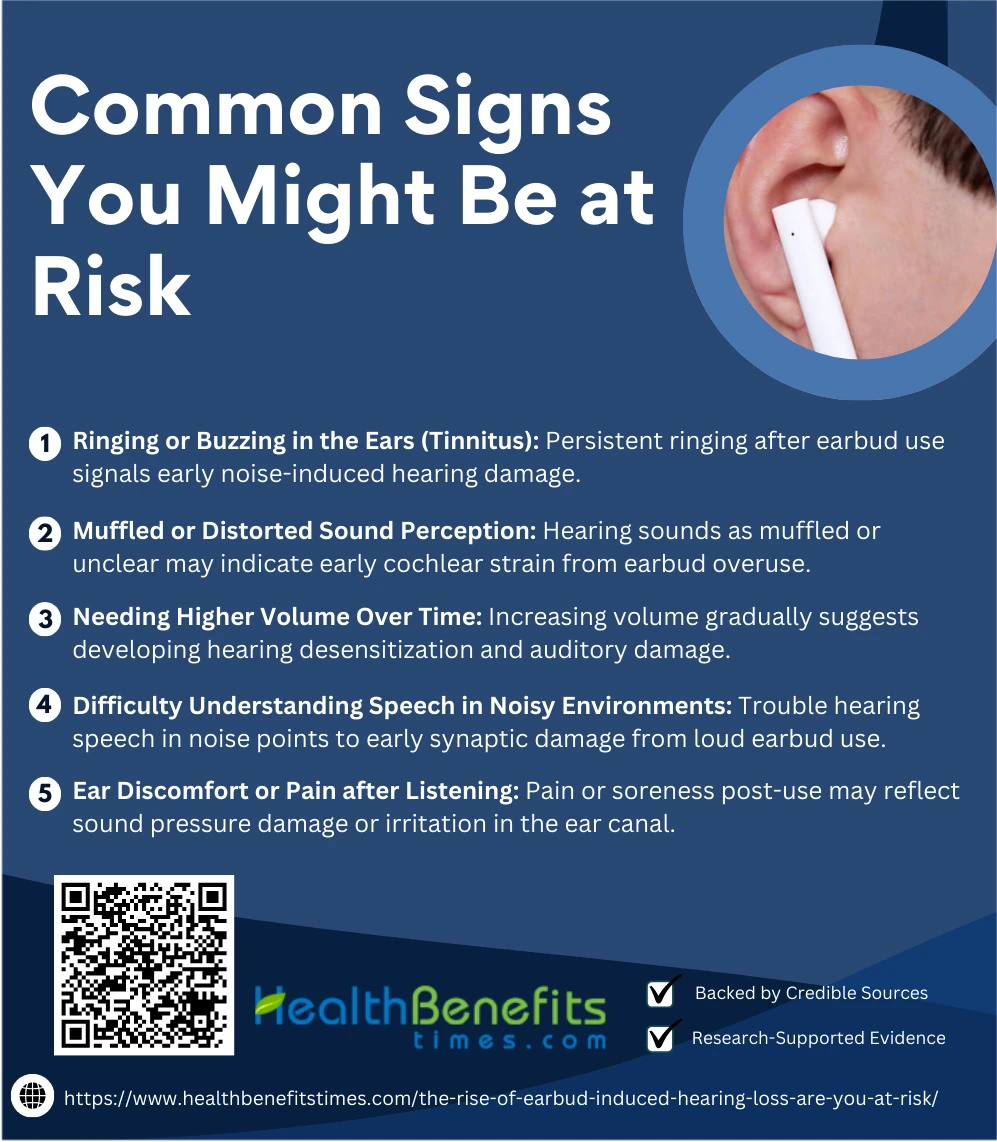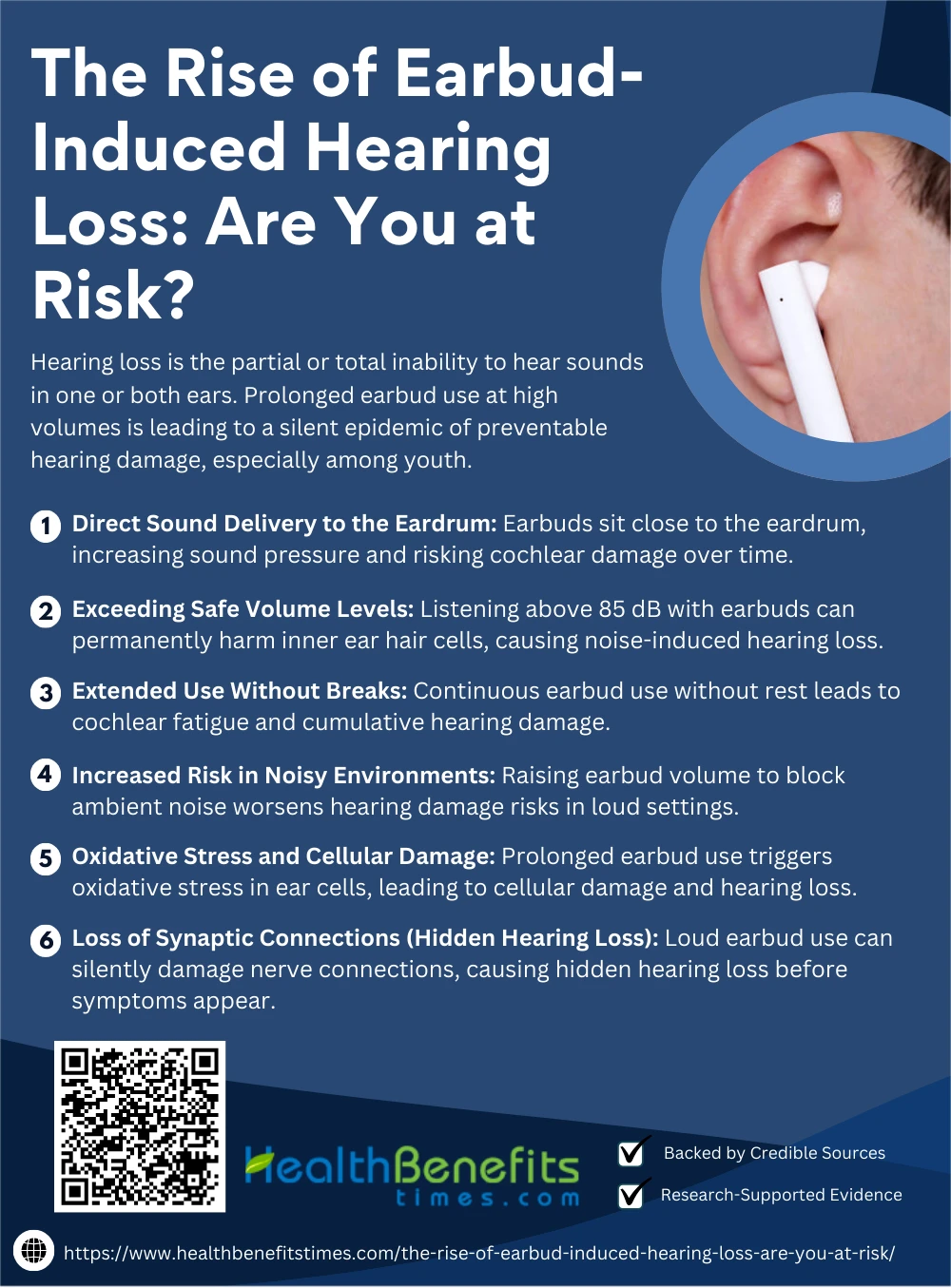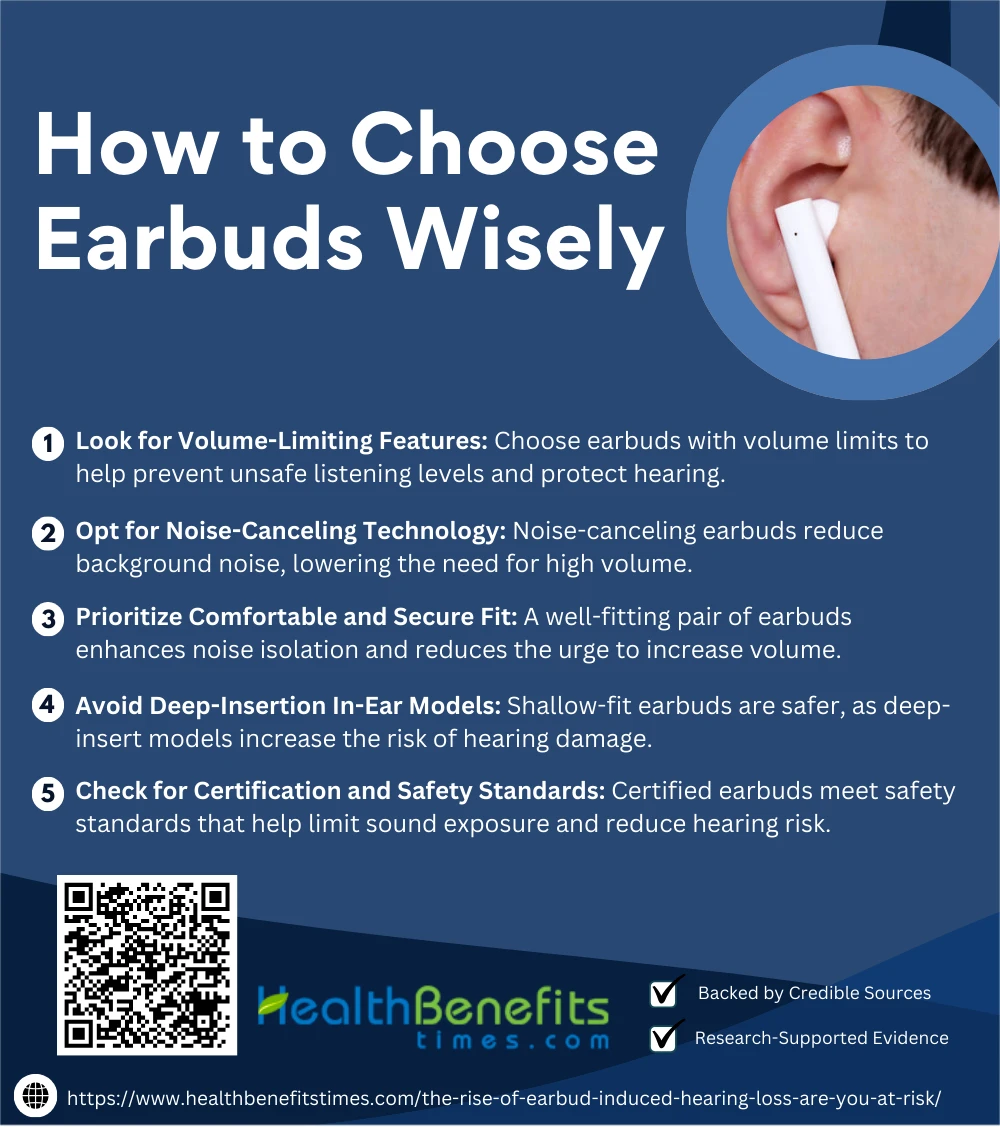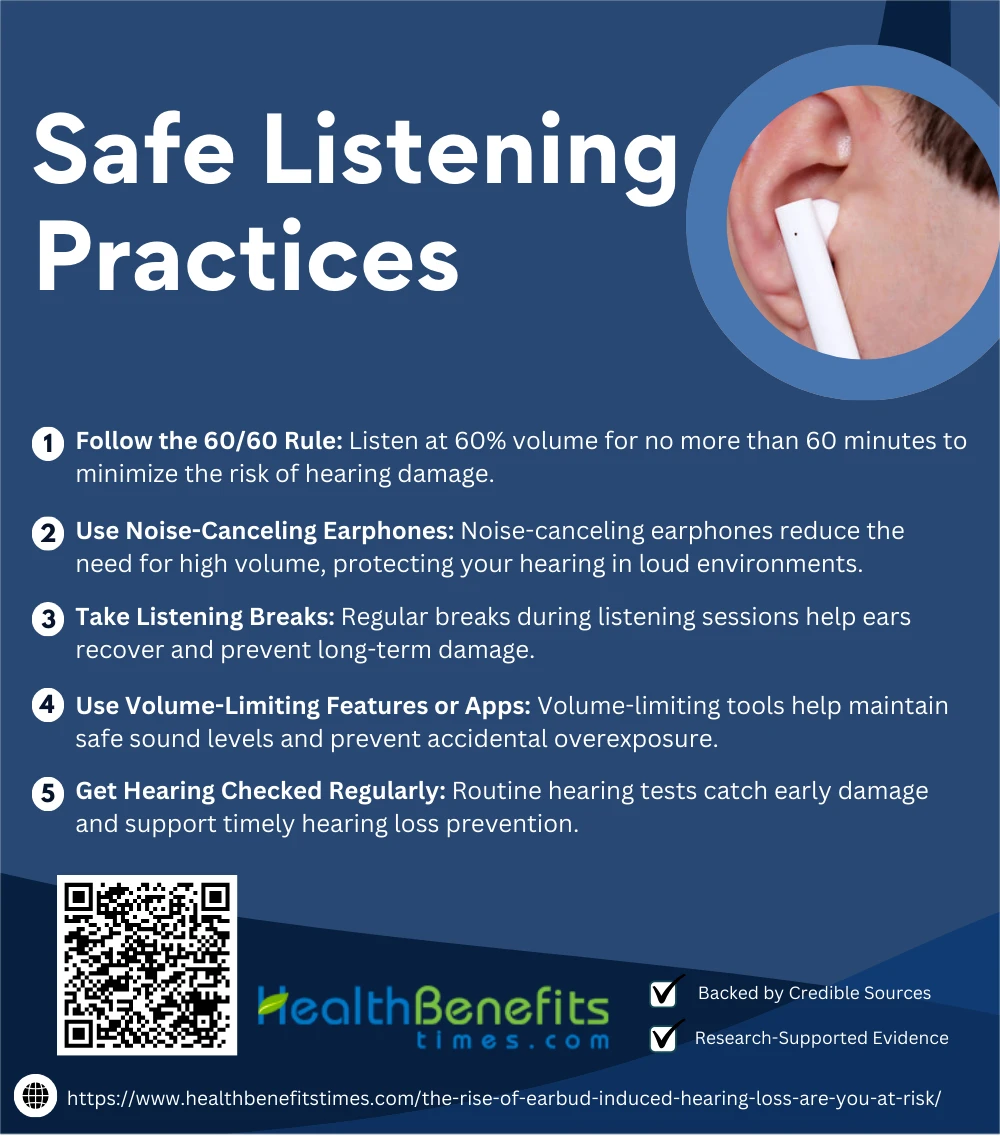- Hearing loss is the partial or total inability to hear sounds in one or both ears.
- Prolonged earbud use at high volumes is leading to a silent epidemic of preventable hearing damage, especially among youth.
- This article explores the causes, risks, and safe listening practices to help you protect your hearing in the digital age.
 An earbud is a compact, in-ear audio device designed to fit directly into the ear canal and deliver sound from digital sources like smartphones or laptops. These devices, often wireless and sleek, are increasingly used for music, calls, and even sleep enhancement. According to a study, earbuds are now a ubiquitous part of daily life, especially among younger populations due to their portability and immersive sound quality.
An earbud is a compact, in-ear audio device designed to fit directly into the ear canal and deliver sound from digital sources like smartphones or laptops. These devices, often wireless and sleek, are increasingly used for music, calls, and even sleep enhancement. According to a study, earbuds are now a ubiquitous part of daily life, especially among younger populations due to their portability and immersive sound quality.
In recent years, the growing popularity of earbuds has coincided with a concerning trend: rising rates of hearing loss, particularly among teens and young adults. The World Health Organization warns that nearly 1.1 billion young people are at risk of hearing damage due to unsafe listening practices involving earbuds and similar devices. Unlike over-the-ear headphones, earbuds sit closer to the eardrum and can amplify sound pressure within the canal, increasing the likelihood of noise-induced hearing loss (NIHL). A 2021 study published in the Russian Bulletin of Hygiene found that excessive earbud use correlated strongly with reported hearing deterioration among adolescents. Meanwhile, insights from JMIR Formative Research show that listeners often underestimate their personal risk, pointing to a widespread lack of awareness and regulation on volume levels. As earbuds continue to define how we experience audio, it’s vital to understand the hidden risks they may pose to long-term auditory health.
Understanding Earbud-Induced Hearing Loss
Earbud-induced hearing loss refers to auditory damage resulting from prolonged or excessive use of in-ear audio devices at unsafe volume levels. It is a subtype of noise-induced hearing loss (NIHL) that occurs when sound exposure exceeds safe decibel thresholds, often damaging the hair cells in the cochlea responsible for sound transmission. (1)
Earbuds, unlike over-the-ear headphones, sit directly in the ear canal, trapping sound waves and increasing sound intensity by up to 9 decibels. (2) This close proximity makes them especially risky when used in noisy environments, leading users to unknowingly crank up the volume. A study from JMIR Formative Research also reveals that many users underestimate their exposure, increasing their vulnerability to long-term damage. (3) Raising awareness of safe listening practices is vital to protecting auditory health in the age of constant connectivity.
Difference between earbuds and over-ear headphones in terms of risk.
Here’s a clear and concise comparison table outlining the differences between earbuds and over-ear headphones specifically in terms of hearing loss risk factors:
| Factor | Earbuds | Over-Ear Headphones |
| Position in Ear | Placed directly into the ear canal | Surround the entire ear without entering the ear canal |
| Sound Proximity to Eardrum | Very close – can increase sound pressure in the canal | Further from the eardrum – more distributed sound |
| Ambient Noise Isolation | Poor (unless noise-canceling), often causes users to increase volume | Better passive noise isolation; users less likely to increase volume |
| Volume Risk | Higher – users often exceed 85 dB in noisy environments | Lower – users tend to listen at safer levels |
| Potential for Damage | Greater risk of damaging cochlear hair cells due to direct sound exposure | Moderate risk – depends on volume and duration |
| Duration of Use | Frequently worn for extended hours (e.g., calls, music, podcasts) | Often used in shorter sessions |
| User Awareness of Volume | Lower – harder to gauge safe listening levels in-ear | Easier to notice discomfort at high volume levels |
| Design Impact on Hearing Health | Riskier for hearing over time, especially without regulation | Safer design due to cushioning and distance from ear canal |
Common Signs You Might Be at Risk
Are your earbuds silently harming your hearing? Many people overlook early symptoms of earbud-induced hearing loss. Recognizing these warning signs early can help you take action before permanent damage occurs.
 1. Ringing or Buzzing in the Ears (Tinnitus)
1. Ringing or Buzzing in the Ears (Tinnitus)
Tinnitus, a persistent ringing or buzzing in the ears, often arises after repeated loud earbud use. It is a hallmark symptom of early noise-induced hearing damage. (4) Research links tinnitus severity directly to exposure duration and volume and confirms its association with irreversible hearing loss. (5)
2. Muffled or Distorted Sound Perception
A sense of muffled hearing or speech distortion is often an early indicator of earbud-induced auditory fatigue. This symptom signals compromised cochlear function due to prolonged exposure, particularly when earbuds are used in noisy settings. (1) (2) Users frequently misjudge safe sound levels, compounding risk. (3)
3. Needing Higher Volume Over Time
Gradually increasing the volume on your earbuds to hear clearly may indicate developing hearing desensitization. This adaptation to louder sound levels is an early symptom of auditory damage. (6) Repeated loud exposure reduces cochlear sensitivity, elevating your risk of long-term hearing loss. (3) (1)
4. Difficulty Understanding Speech in Noisy Environments
Struggling to distinguish speech in crowded or noisy spaces—despite normal hearing tests—is a classic early sign of cochlear synaptopathy caused by loud earbud use. (7) Even slight damage from overuse can impair signal processing and degrade speech-in-noise perception. (4) (2)
5. Ear Discomfort or Pain after Listening
Pain or soreness after using earbuds can signal excessive sound pressure or irritation in the auditory canal—an early warning of potential damage. Studies associate such discomfort with prolonged high-decibel exposure, infection risk, and structural ear issues linked to hearing loss. (8) (9) (10)
How Earbuds Damage Your Hearing
Earbuds may seem harmless, but their close proximity to your eardrums can cause serious harm. Understanding how they damage your hearing helps you make safer choices for long-term ear health.
 1. Direct Sound Delivery to the Eardrum
1. Direct Sound Delivery to the Eardrum
Earbuds are positioned deep within the ear canal, bringing the sound source dangerously close to the eardrum. This proximity significantly increases sound pressure on auditory structures, leading to cochlear damage over time. (11) (2) (12) (13) (14) Over time, this localized acoustic intensity causes sensorineural hearing loss, especially when used at high volumes or for extended periods.
2. Exceeding Safe Volume Levels
Many users exceed safe sound levels (above 85 dB) while using earbuds, often without realizing the irreversible damage it causes. Continuous exposure above this threshold damages inner ear hair cells, leading to Noise-Induced Hearing Loss (NIHL). (15) (16) (2) (17) (18) Repeatedly raising the volume to overcome ambient noise accelerates auditory fatigue, especially among adolescents and frequent commuters.
3. Extended Use Without Breaks
Prolonged earbud use without breaks can cause irreversible damage to inner ear structures, particularly the hair cells responsible for transmitting sound. Research from ScienceDirect highlights that continuous exposure to moderate-level audio can cause cochlear fatigue. (19) The CDC warns that even non-industrial sounds like music can lead to cumulative damage. (20) A WHO study shows that over 1 billion young adults are at risk. (21) Furthermore, NIH findings suggest auditory overstimulation without recovery time accelerates hearing threshold shifts. (22) Regular breaks are advised by NEJM to allow ear recovery.
4. Increased Risk in Noisy Environments
Using earbuds in already noisy environments like public transport or city streets increases hearing damage risk due to volume escalation. Studies from ScienceDirect confirm that individuals increase audio levels to mask ambient noise, often exceeding safe thresholds. (23) The WHO warns that this behavior amplifies the risk of noise-induced hearing loss. (24) According to CDC, this effect is more harmful than industrial exposure. (20) NIH research emphasizes how constant background noise aggravates ear fatigue. (25) The NEJM underscores prevention through environmental awareness and limiting listening time.
5. Oxidative Stress and Cellular Damage
Excessive earbud use contributes to oxidative stress in cochlear cells, leading to apoptosis and hearing deterioration. According to ScienceDirect, reactive oxygen species (ROS) accumulate from sustained noise exposure. (26) The WHO outlines oxidative damage as a significant risk for noise-induced hearing loss. (27) Studies from the NIH confirm that prolonged audio stimulation disrupts mitochondrial function. (28) The CDC reinforces this link, while NEJM connects oxidative stress with cumulative cochlear injury. (20)
6. Loss of Synaptic Connections (Hidden Hearing Loss)
Listening to music at high volumes through earbuds may damage auditory nerve fibers by disrupting synaptic connections between inner hair cells and neurons. ScienceDirect explains that even temporary noise can cause “hidden hearing loss” by severing these synapses. (19) Research from the NIH details how glutamate excitotoxicity leads to synaptic rupture. (29) The CDC highlights early neural damage risks in youth. (30) The WHO urges limiting volume and duration, supported by findings from the NEJM linking synaptic loss to early auditory decline. (31)
Why Earbuds Pose a Greater Risk than You Think
Earbuds, due to their close proximity to the eardrum, can cause greater harm than over-ear headphones. The CDC emphasizes that small devices can produce dangerously high sound levels. (20) ScienceDirect shows prolonged use disrupts cochlear homeostasis. (19) The NIH warns of early synaptic degradation. (25) WHO reports over 50% of young people are at risk. (24) Additionally, NEJM links casual use with accelerated auditory aging.
Who are at Risk?
Earbud-induced hearing loss can affect anyone, but some groups are more vulnerable. Teens, young adults, and frequent users are especially at risk due to prolonged exposure to high-volume audio.
Young people between the ages of 12 and 35 are among the most vulnerable to earbud-induced hearing loss. This demographic often listens to music at high volumes for extended periods, frequently without breaks. The World Health Organization has warned that over 1 billion young individuals globally are at risk due to unsafe listening practices, especially in recreational settings like commuting or exercising with earbuds. (24)
2. Urban Commuters
People commuting in noisy urban environments—such as on public transport or walking through traffic—tend to increase the volume on their earbuds to overcome background noise. This volume escalation often crosses safe listening thresholds, posing serious long-term auditory risks. According to the CDC, noise levels above 70 dB over prolonged periods can start damaging hearing, a common occurrence during daily commutes. (20)
3. Gamers and Streamers
Gamers and streamers often use earbuds or headphones for hours at a time, immersing themselves in high-fidelity or high-volume soundscapes. This consistent exposure without auditory breaks leads to neural and cochlear stress. A ScienceDirect study linked extended recreational noise exposure to early signs of hearing loss, particularly among individuals engaging in long-duration gaming sessions. (23)
4. Music Industry Professionals
Professionals working with audio—such as musicians, sound engineers, and DJs—are exposed to high-decibel sound environments routinely, often through in-ear monitors. Chronic use of earbuds in studio and live settings has been linked to hair cell damage and cochlear degeneration. Research by the NIH highlights the occupational hazard faced by this group, especially when proper hearing protection isn’t employed. (22)
5. Children Using Tablets or Phones
Children, particularly those who frequently use digital devices like tablets and smartphones, are increasingly using earbuds at volumes harmful to their developing ears. The earlier hearing structures are exposed to loud sounds, the higher the lifetime risk of auditory impairment. The New England Journal of Medicine underscores that children are biologically more susceptible to noise-induced damage due to immature cochlear defenses.
Safe Listening Practices
Protecting your hearing starts with safe listening habits. Simple changes like managing volume, limiting usage time, and using noise-canceling features can make a big difference in preventing earbud-induced hearing loss.
The 60/60 rule—listening at 60% volume for no more than 60 minutes—helps prevent noise-induced hearing loss. The WHO recommends this guideline to reduce auditory damage. (21) CDC data supports moderated listening for safer hearing, while NIH research highlights cumulative harm from high-volume, prolonged audio exposure. (22) (30)
2. Use Noise-Canceling Earphones
Noise-canceling earphones reduce the need to increase volume in loud environments, helping protect inner ear structures. According to ScienceDirect, these devices lower auditory strain. (23) The CDC advises their use over regular earbuds. (20) NIH findings confirm their effectiveness in maintaining safer listening levels. (25)
3. Take Listening Breaks
Frequent breaks during listening sessions allow auditory cells to recover from overstimulation. ScienceDirect shows pauses reduce cochlear fatigue. (19) The WHO advises limiting continuous exposure, and NIH research confirms that rest periods lower oxidative stress and prevent irreversible hearing damage. (24) (28)
4. Use Volume-Limiting Features or Apps
Volume-limiting settings help prevent accidental overexposure to harmful sound levels. The CDC supports tech-based hearing protection. (30) According to ScienceDirect, limiting output reduces cumulative auditory stress. (23) NIH findings highlight volume control as a key preventative strategy in youth hearing conservation. (22)
5. Get Hearing Checked Regularly
Routine hearing assessments enable early detection of damage and promote timely intervention. The CDC advises annual screenings for high-risk groups. (32) NIH research shows early diagnosis reduces long-term impairment. (25) NEJM supports preventive audiology to manage progressive hearing loss effectively.
How to Choose Earbuds Wisely
Not all earbuds are created equal when it comes to ear health. Choosing the right pair with safety features like volume limits and noise isolation can significantly reduce your hearing risk.
 1. Look for Volume-Limiting Features
1. Look for Volume-Limiting Features
Earbuds with volume-limiting technology prevent users from exceeding safe sound thresholds. The CDC recommends them to reduce youth hearing damage. (30) WHO emphasizes safe listening levels, while NIH supports tech-based interventions to minimize exposure and support auditory health long term. (21) (22)
2. Opt for Noise-Canceling Technology
Noise-canceling earbuds minimize background sound, helping users keep volumes lower. ScienceDirect finds they reduce auditory strain significantly. (23) The CDC encourages their use in noisy settings, while NIH links them with reduced cochlear damage compared to regular models. (25) (20)
3. Prioritize Comfortable and Secure Fit
A secure, ergonomic fit reduces sound leakage and avoids the need to increase volume. NIH research shows discomfort often leads to overexposure. (22) ScienceDirect highlights that proper fit enhances passive noise isolation. (19) The CDC emphasizes comfort as key in safe listening behavior. (20)
4. Avoid Deep-Insertion In-Ear Models
Deep-insertion earbuds bring sound dangerously close to the eardrum, increasing the risk of damage. The WHO advises using shallow-fit models. (24) NEJM links close-range exposure to accelerated hearing loss, while NIH notes greater incidence of tinnitus and discomfort with deep-insert models. (25)
5. Check for Certification and Safety Standards
Selecting earbuds certified for safe listening ensures they meet regulated sound exposure limits. The WHO promotes standards that cap output levels to reduce hearing loss risk. (24) NIH highlights the importance of regulatory compliance, and NEJM stresses adopting certified products for long-term auditory protection. (25)
When to See a Specialist
Hearing loss that develops suddenly, worsens over time, or is accompanied by symptoms like tinnitus or vertigo warrants specialist consultation. The CDC advises seeing an audiologist if hearing loss affects daily life or communication. (20) NIH research links untreated hearing loss to cognitive decline. (25) According to ScienceDirect, early intervention can prevent irreversible cochlear damage. (33) The WHO recommends prompt assessment for high-risk individuals. (34) NEJM emphasizes that seeing a specialist early improves long-term auditory and mental health outcomes.
Conclusion
Earbud-induced hearing loss is a growing concern in our tech-driven world, where constant audio exposure is part of daily life. While earbuds offer convenience and portability, their improper use can quietly damage your hearing over time. Recognizing the risks, symptoms, and adopting safer listening habits—like managing volume levels, limiting usage time, and choosing the right earbuds—can make a significant difference. Your hearing is precious and irreplaceable, and protecting it should be a priority. Whether you’re a student, professional, or fitness enthusiast, taking action now can prevent future complications. Listen smart, stay aware, and safeguard your ears for a healthier tomorrow.




